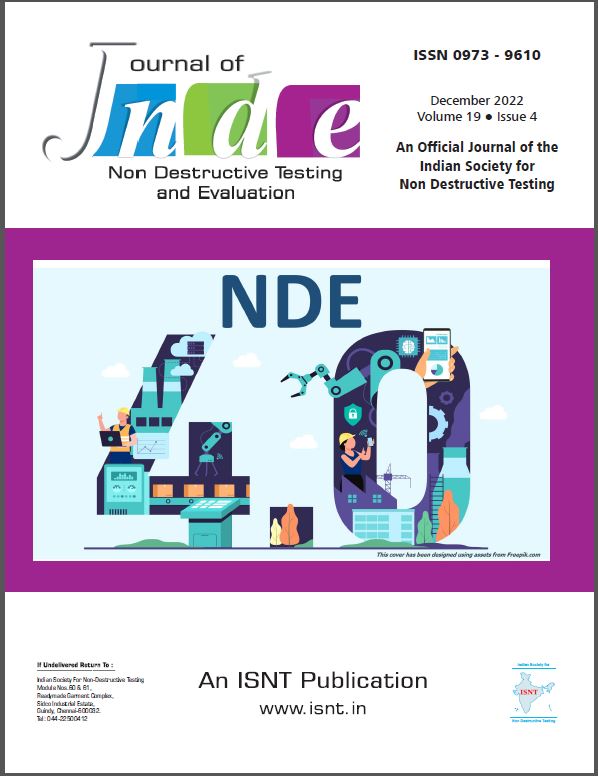
Published 25-11-2022
Keywords
- PAUT,
- Digital X-Ray,
- Radiography,
- ADR,
- Simulation
- Assisted ...More
How to Cite
Copyright (c) 2022 Journal of Non-Destructive Testing and Evaluation (JNDE)

This work is licensed under a Creative Commons Attribution-NonCommercial-NoDerivatives 4.0 International License.
Abstract
The paper highlights a new paradigm using simulation-based analysis that employs physics-based models in parallel processing using GPU for rapid generation of synthetic data sets. This paper discusses the development of a Simulation Assisted ADR (Automatic Defect Recognition) using the physics-based simulation models of the different NDE/NDT imaging modalities as well as Deep Learning (DL) and/or Machine Learning (ML) models. Our approach addresses the classic issues during the implementation of DL/ML approach to Radiography and Ultrasonics based NDE/NDT data interpretation that includes lack of sufficient apriori data as well as biases in the data sets, among others. Here, using the limited experimental/field NDE/NDT data sets that are available and by deriving critical statistical distribution parameters from this data set, the stochastics of the simulation models are determined. Thereby, the simulated data sets are generated using numerical simulations along with the variations in the different parameters during experimental/field data acquisition. This process allows the generation of simulated data sets in large quantity that augments the smaller data sets obtained experimentally. This rich data set is subsequently utilized to train the DL models and provide reliable ADR algorithms. Weld and AL casting radiography data sets from Digital X-ray Images and PAUT (with FMC/TFM) are both used to demonstrate the SimADR approach.
References
- Liao TW, Li Y (1998) An automated radiographic NDT system for weld inspection: Part ii—flaw detection. Ndt & E International 31(3):183–192
- Zahran O, Kasban H, El-Kordy M, Abd El-Samie F (2013) Automatic weld defect identification from radiographic images. Ndt & E International 57:26–35
- Lashkia V (2001) Defect detection in x-ray images using fuzzy reasoning. Image and vision Computing 19(5):261–269
- Ferguson MK, Ronay A, Lee YTT, Law KH (2018) Detection and seg- mentation of manufacturing defects with convolutional neural networks and transfer learning. Smart and sustainable manufacturing systems 2
- Mery D, Riffo V, Zscherpel U, Mondrag´on G, Lillo I, Zuccar I, Lobel H, Carrasco M (2015) Gdxray: The database of x-ray images for nondestruc- tive testing. Journal of Nondestructive Evaluation 34(4):42
- Ren S, He K, Girshick R, Sun J (2015) Faster r-cnn: Towards real-time object detection with region proposal networks. In: Advances in neural information processing systems, pp 91–99
- Drinkwater BW, Wilcox PD, Ultrasonic arrays for non- destructive evaluation a review, NDT and E International, 39, 525-41, 2006.
- Schmerr LW, Fundamentals of ultrasonic nondestructive evaluation-a modeling approach. New York: Plenum press;1998.
- Verkooijen J, Boulavinov A, Sampling phased array a new technique for signal processing and ultrasonic imaging, Berlin, ECNDT, 2006.
- M. Jobst, G. Connolly, Demonstration of the Application of the Total Focusing Method to the Inspections of Steel Welds, ECNDT, paper 1.3.4, 2010.
- Felice MV, Velichko A, Wilcox PD. Accurate depth measurement of small surface-breaking cracks using an ultrasonic array post-processing technique. NDT & E International. 68(105-112), 2014.
- Robert L. Harrison, Introduction To Monte Carlo Simulation, AIP Conf Proc., 1204: 17-21, 2010.
- Duvauchelle, Philippe & Freud, Nicolas & Kaftandjian, Valerie & Babot, Daniel. (2000). Computer code to simulate X-ray imaging techniques. Nuclear Instruments and Methods in Physics Research Section B: Beam Interactions with Materials and Atoms. 170. 245-258. 10.1016/S0168-583X(00)00185-3.
- Lazos D, Bliznakova K, Kolitsi Z, Pallikarakis N. An integrated research tool for X-ray imaging simulation. Comput Methods Programs Biomed. 2003 Mar;70(3):241-51. doi: 10.1016/s0169-2607(02)00015-9. PMID: 12581556.
- Fanti V, Marzeddu R, Massazza G, Randaccio P. A simulation tool to support teaching and learning the operation of X-ray imaging systems. Med Eng Phys. 2005,Sep;27(7):555-9.doi: 10.1016 /j.medengphy. 2004.11.010. PMID: 16040266.
- Bellon, C., Jaenisch, G.R.: Artist-analytical rt inspection simulation tool. In: Proc DIR, pp. 25-27 (2007).
- D. Gambda, U. Sreedhar, K. Balasubramaniam, P. Purushothaman, M. Sureka, and B. Ghose “Automatic defect recognition on X-ray radiographs of solid propellant using deep learning based on convolutional neural network." J. Nondestructive Evaluation, 40(18) doi.org/10.1007/s10921-021-00750-4 (2021).
- Munir, N., Kim, H., Park, J., Song, S., Kang, S.: Convolutional neural network for ultrasonic weldment flaw classification in noisy conditions. Ultrasonics (2019).
- Maayan FA, Idit D, Eyal K, Michal A, Jacob G, Hayit G, GAN-based Synthetic Medical Image Augmentation for increased CNN Performance in Liver Lesion Classification, Neurocomputing, Vol 321, PP. 321-331, 2018.
- I. Goodfellow I, J. Pouget-Abadie, M. Mirza, B. Xu, D. Warde-Farley, S. Ozair, A. Courville, and Y. Bengio, Generative adversarial nets, in Advances in neural information processing systems, pp. 2672{2680, 2014.
- A. Radford, L. Metz, and S. Chintala, Unsupervised presentation learning with deep convolutional generative adversarial networks, arXiv preprint arXiv:1511.06434, 2015.
- Gantala T, and K. Balasubramaniam, Automated Defect Recognition for Welds using Simulation Assisted TFM Imaging with Artificial Intelligence, J. Nondestructive Evaluation, 40(28) doi.org/10.1007/s10921-021-00761-1 (2021).
- Alexey, B.,Wang, C.-Y., Liao, H.-Y.: YOLOv4: optimal speed and accuracy of object detection, computer vision and pattern recognition, arXiv preprint arXiv:2004.10934v1 (2020).
- Redmon, J., Santosh,D., Ross, G., Farhadi, A.: You only look once: unified, real-time object detection, computer vision and pattern recognition, arXiv preprint arXiv:1506.02640v5 (2016).
